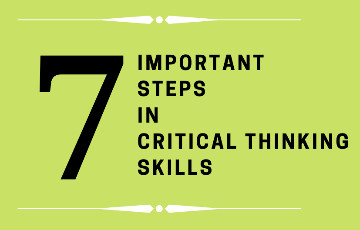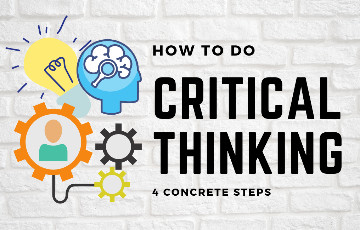
Find out about the 7 essential steps of developing critical thinking skills. Enhance your ability to analyze, evaluate, and problem-solve effectively.
Step 1: Identify
Based on what we see and hear, we assume that this could be the problem. But, a critical thinker will do things differently. They will ask
- Is it the real problem
- Is it the reflection of an actual problem that is somewhere
- Is it a part of a bigger problem or just a minor issue etc.
They look for core problem areas first. Critical thinking skills are to identify the heart of the problem and not what appears in plain sight.
Among the 7 steps of critical thinking skills, “Identifying” is where critical thinkers spend most of their time before proceeding to other steps.
Step 2: Gather
The second step is to gather data, opinions, arguments, resources, and everything you can about the problem. Apart from other sources, do your research and have independent self-arguments, angles, and ideas to approach the problem.
Step 3: Analyze
With all gathered data, begin analyzing and evaluating it. Find out the credibility. It’s the best part of the critical thinking step because you get to find the following:
- What is true?
- What is right?
- Is it valid for the present situation?
- Are these sources reliable?
- Is it a valid argument based on facts or just personal opinions?
- Is the data enough? Etc.
Step 4: Interpret
Another important critical thinking step is interpretation. You find out what applies to the problem from all analyzed data and pick the most appropriate ones. You remove irrelevancies from the equation.
Step 5: Establish
Establish your ideas and inferences. Be open-minded and accept other perspectives here.
Step 6: Decide
Finally, go through all the ideas and decide on one final suitable solution.
Step 7: Communicate:
Once you have finalized the solution, communicate it to people. Good communication is important in critical thinking.

1. Evaluate:
The first step in critical thinking is to evaluate what is before you. You need to ask clear and fundamental questions for analyzing the situation thoroughly. In short, If you have a problem, ask basic questions about the problem like:
- Why did it happen?
- Am I responsible in a way?
- What caused it?
- What’s the possible solution? Etc.
Point is: The ability to get to the heart of the problem shows good critical thinking.
2. Credibility:
Analyzing and testing the Credibility of Data is important in critical thinking. Is it valid data? Is it true? How trustable is the source? What advantages it has? What’s the motive behind this? etc. are questions you need to ask. Drawing conclusions with insufficient or false data without applying logic stops critical reasoning and thinking.
Point is: Critical thinking is to “respond first” by analyzing what the problem/information is. It is not about reacting by just seeing the information. How you respond marks a critical thinking habit.
3. Different Perspectives:
Critical thinking is gathering perspectives outside your own. Have your ideas. Also, get foresight from other people. See the differences and similarities. Analyze the possibilities of finding the right solution.
Point is: Critical Thinking is to listen, assess, and gather fresh perspectives along with yours.
4. Is it A-B or B-A?
For instance, you are sure that ‘A’ caused ‘B’. But, what if, ‘B’ caused ‘A”. Instead of thinking straight, the idea here is to flip the usual thinking angle and see reversely.
Point is: Flipping the thinking angle will give a different perspective to think about the problems.
Takeaway:
Critical thinking is about looking through a wide glass instead of a keyhole. It’s about thinking via different perspectives and angles to find what’s right and apt.


